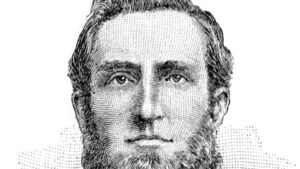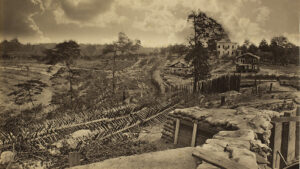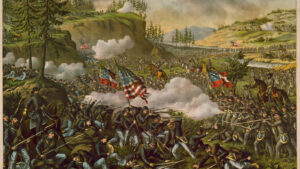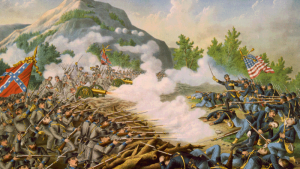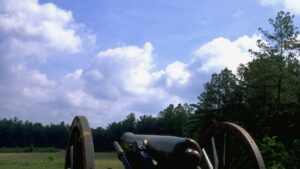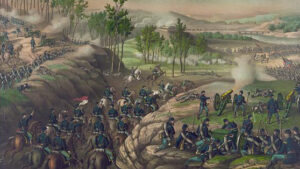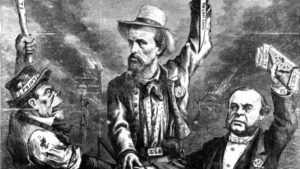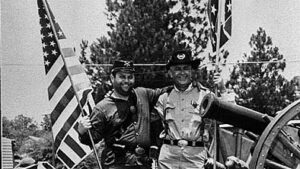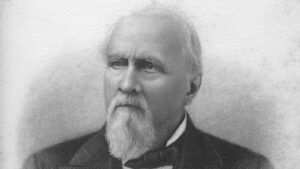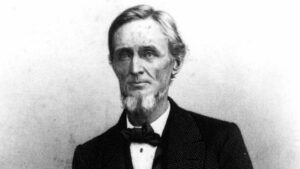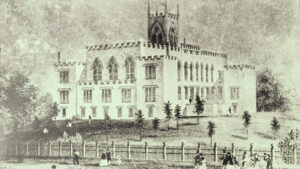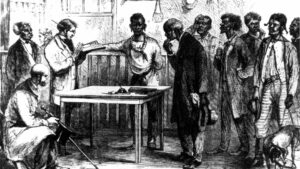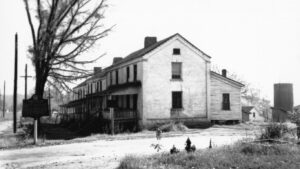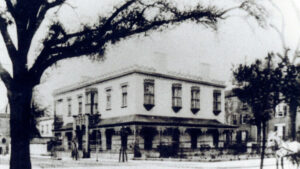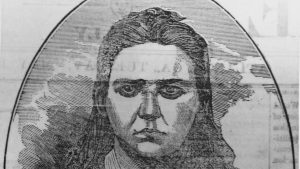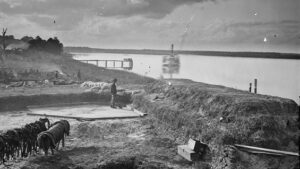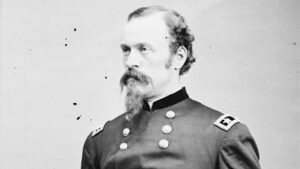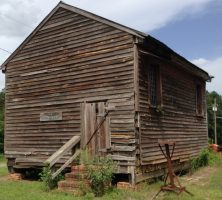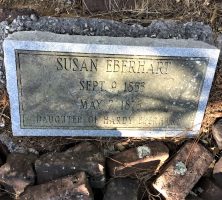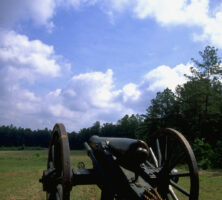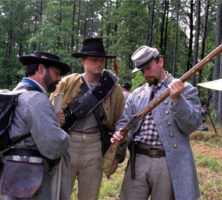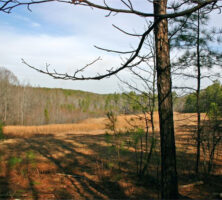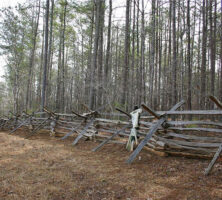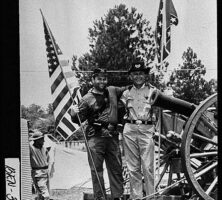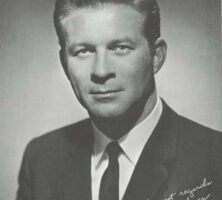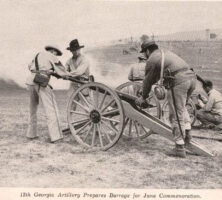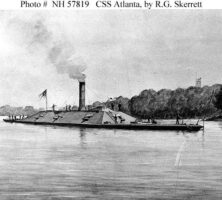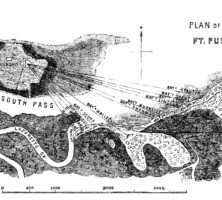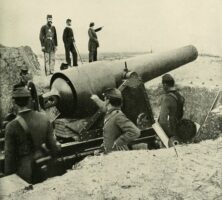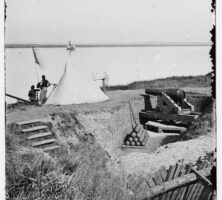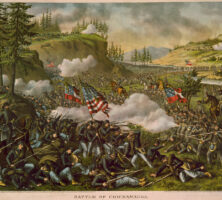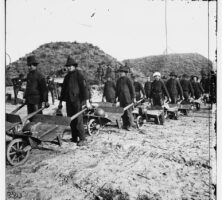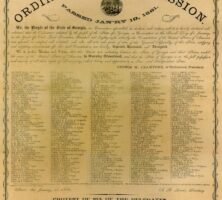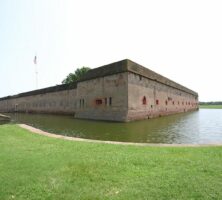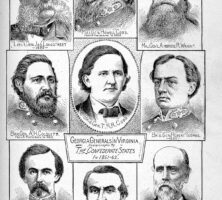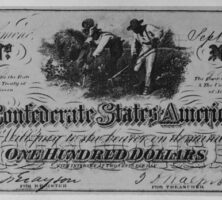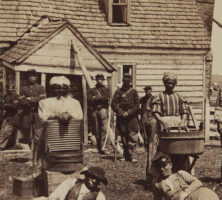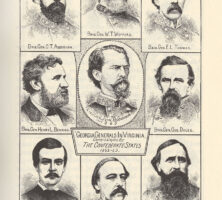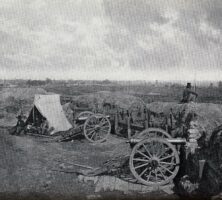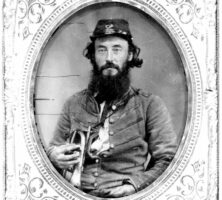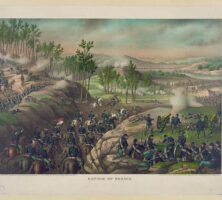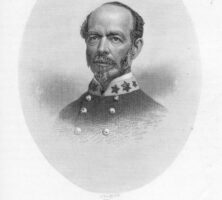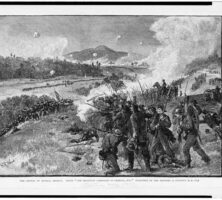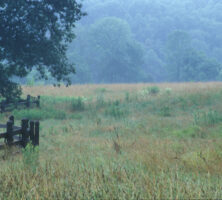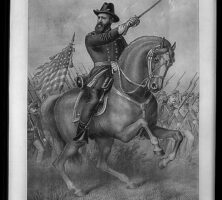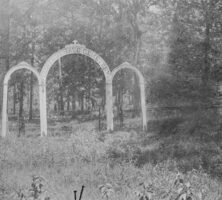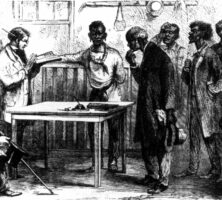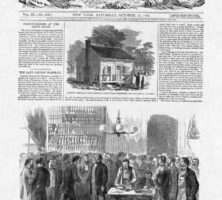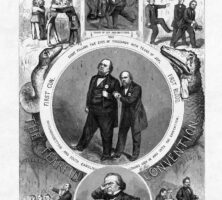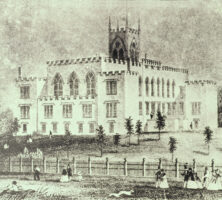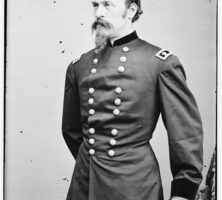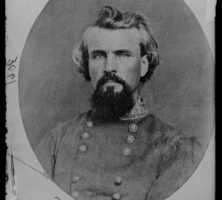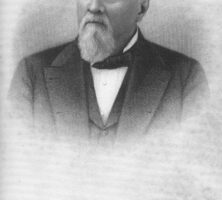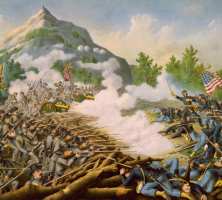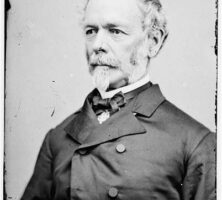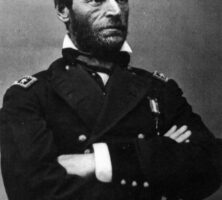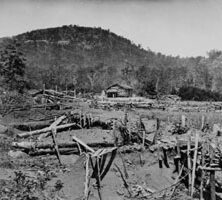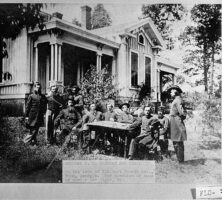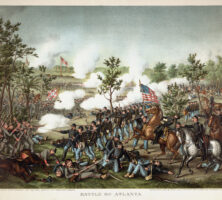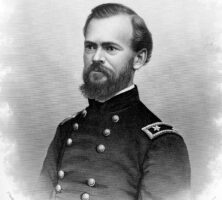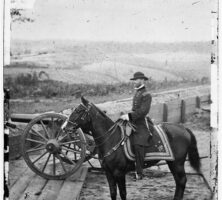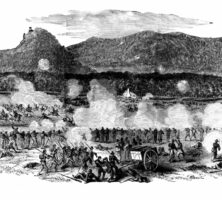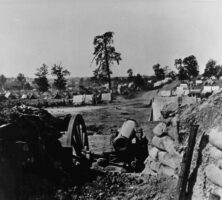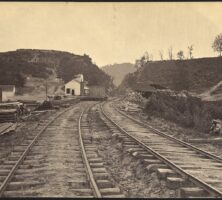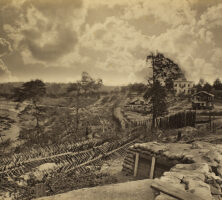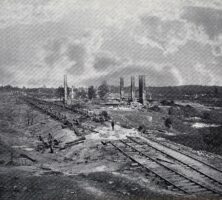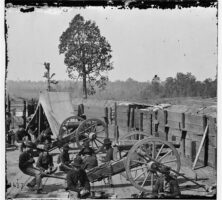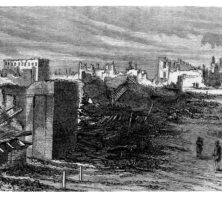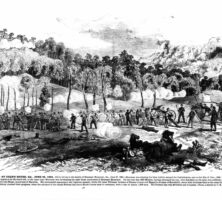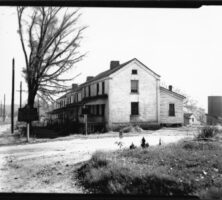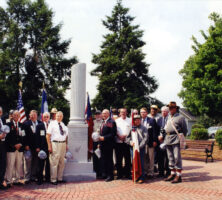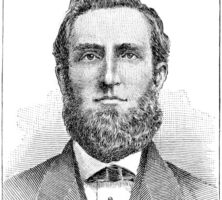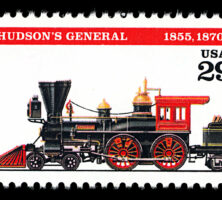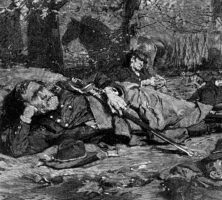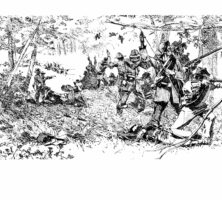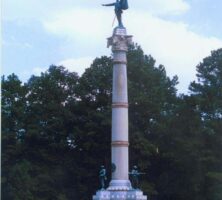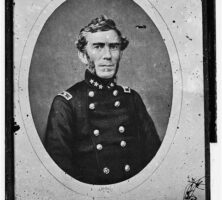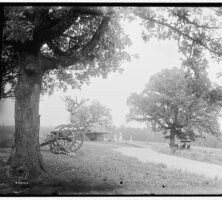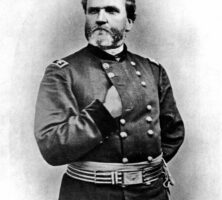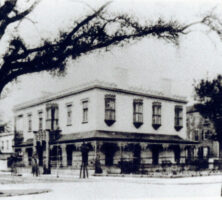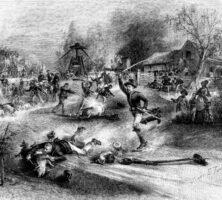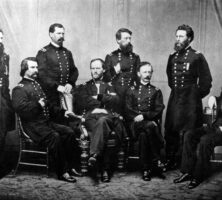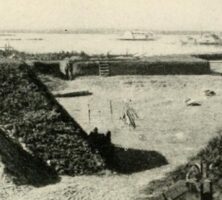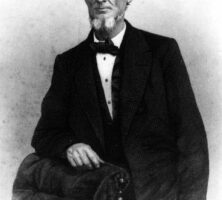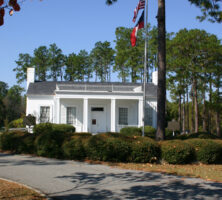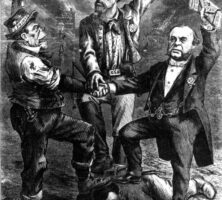The New Georgia Encyclopedia is supported by funding from A More Perfect Union, a special initiative of the National Endowment for the Humanities.
Prior to her execution, Susan Eberhart was held in the old Webster County jail, shown here in 2019. Built in 1856, the jail is among the oldest wooden jails in Georgia.
Courtesy of Fay S. Burnett
The New Georgia Encyclopedia does not hold the copyright for this media resource and can neither grant nor deny permission to republish or reproduce the image online or in print. All requests for permission to publish or reproduce the resource must be submitted to the rights holder.
In 1873 twenty-year-old Susan Eberhart was convicted of murder and sentenced to death by hanging in Preston. Eberhart's highly publicized execution had a significant influence on the administration of capital punishment in Georgia.
From The Atlanta Daily Sun
The New Georgia Encyclopedia does not hold the copyright for this media resource and can neither grant nor deny permission to republish or reproduce the image online or in print. All requests for permission to publish or reproduce the resource must be submitted to the rights holder.
In 1873 Susan Eberhart was executed for the murder of Sarah Spann despite objections from a sympathetic public. Her gravestone, seen here in 2019, sits in Preston Cemetery in Webster County.
Courtesy of Fay S. Burnett
The New Georgia Encyclopedia does not hold the copyright for this media resource and can neither grant nor deny permission to republish or reproduce the image online or in print. All requests for permission to publish or reproduce the resource must be submitted to the rights holder.
A cannon stands at the Pickett's Mill Battlefield Historic Site in Paulding County, the site of a battle in May 1864 in which Confederate forces prevented Union general William T. Sherman's troops from moving on Atlanta.
Courtesy of Pickett's Mill Battlefield Historic Site
The New Georgia Encyclopedia does not hold the copyright for this media resource and can neither grant nor deny permission to republish or reproduce the image online or in print. All requests for permission to publish or reproduce the resource must be submitted to the rights holder.
The New Georgia Encyclopedia does not hold the copyright for this media resource and can neither grant nor deny permission to republish or reproduce the image online or in print. All requests for permission to publish or reproduce the resource must be submitted to the rights holder.
Reenactors of the Battle of Pickett's Mill examine weaponry. The battle, which prevented the Union advance on Atlanta during the Civil War, took place in Paulding County in May 1864.
Courtesy of Pickett's Mill Battlefield Historic Site
The New Georgia Encyclopedia does not hold the copyright for this media resource and can neither grant nor deny permission to republish or reproduce the image online or in print. All requests for permission to publish or reproduce the resource must be submitted to the rights holder.
The site of the Battle of Pickett's Mill, covering 765 acres in Paulding County, was gradually acquired by the state from 1973 until 1981. In 1990 the park opened to the public as the Pickett's Mill Battlefield Historic Site, commemorating the Civil War battle that took place there in May 1864.
Courtesy of Pickett's Mill Battlefield Historic Site
The New Georgia Encyclopedia does not hold the copyright for this media resource and can neither grant nor deny permission to republish or reproduce the image online or in print. All requests for permission to publish or reproduce the resource must be submitted to the rights holder.
Earthworks built during the Battle of Pickett's Mill, a Civil War engagement that occurred in May 1864, are still evident at the Pickett's Mill Battlefield Historic Site in Paulding County.
Courtesy of Pickett's Mill Battlefield Historic Site
The New Georgia Encyclopedia does not hold the copyright for this media resource and can neither grant nor deny permission to republish or reproduce the image online or in print. All requests for permission to publish or reproduce the resource must be submitted to the rights holder.
Grandsons of Union and Confederate Civil War veterans are pictured in 1965 at the "Blue and Gray Days" event in Fitzgerald during the Civil War Centennial. Centennial events, held from 1961 to 1965, commemorated the 100th anniversary of the Civil War.
Courtesy of Georgia Archives, Vanishing Georgia, #
ben312.
The New Georgia Encyclopedia does not hold the copyright for this media resource and can neither grant nor deny permission to republish or reproduce the image online or in print. Requests for permission to publish or reproduce the resource should be submitted to the Georgia Archives.
Peter Zack Geer served as the first chairman of the Georgia Civil War Centennial Commission, beginning in 1959. In 1963 he was elected lieutenant governor of Georgia.
The New Georgia Encyclopedia does not hold the copyright for this media resource and can neither grant nor deny permission to republish or reproduce the image online or in print. Requests for permission to publish or reproduce the resource should be submitted to the Hargrett Manuscript and Rare Book Library at the University of Georgia.
Confederate reenactors crew a half-scale cannon at the Civil War centennial reenactment of the Battle of Kennesaw Mountain in June 1964.
From Centennial Commemoration, Battle of Kennesaw Mountain--June 27, 1864-1964: Official Souvenir Program
The New Georgia Encyclopedia does not hold the copyright for this media resource and can neither grant nor deny permission to republish or reproduce the image online or in print. All requests for permission to publish or reproduce the resource must be submitted to the rights holder.
The Civil War Centennial in Georgia ended in 1965 with the mayor of Fitzgerald stamping a letter with a cancellation stamp reading "Georgia's Grand Finale Civil War Centennial."
Courtesy of Georgia Archives, Vanishing Georgia, #
ben353.
The New Georgia Encyclopedia does not hold the copyright for this media resource and can neither grant nor deny permission to republish or reproduce the image online or in print. Requests for permission to publish or reproduce the resource should be submitted to the Georgia Archives.
Fort McAllister, situated on the Ogeechee River in Bryan County, played a key role in the defense of Savannah from Union forces during the Civil War. The fort is pictured circa 1864, the year in which it was captured by Union general William T. Sherman's forces.
Courtesy of Library of Congress, Prints and Photographs Division
The New Georgia Encyclopedia does not hold the copyright for this media resource and can neither grant nor deny permission to republish or reproduce the image online or in print. All requests for permission to publish or reproduce the resource must be submitted to the rights holder.
The Fingal was employed in November 1861 by blockade-runner Edward C. Anderson to bring much-needed supplies for the Confederacy into Savannah during the Civil War. The Fingal's success in breaking the blockade alerted Union forces to secure waters off the Georgia coast. While built as a British merchant ship, the blockade-running Fingal was converted to an ironclad in 1862 and renamed the Atlanta.
Courtesy of U.S. Naval Historical Center
The New Georgia Encyclopedia does not hold the copyright for this media resource and can neither grant nor deny permission to republish or reproduce the image online or in print. All requests for permission to publish or reproduce the resource must be submitted to the rights holder.
The New Georgia Encyclopedia does not hold the copyright for this media resource and can neither grant nor deny permission to republish or reproduce the image online or in print. All requests for permission to publish or reproduce the resource must be submitted to the rights holder.
Union captain Quincy Gillmore of the Engineer Corps, in charge of preparing the siege on Fort Pulaski, ordered his engineers to construct a series of eleven artillery batteries along the north shore of Tybee Island.
Courtesy of Georgia Historical Society.
The New Georgia Encyclopedia does not hold the copyright for this media resource and can neither grant nor deny permission to republish or reproduce the image online or in print. All requests for permission to publish or reproduce the resource must be submitted to Georgia Historical Society.
During 1862 and 1863, Fort McAllister repelled seven Union naval attacks. Fort McAllister never fell to Union naval forces because of its unique earthen construction. In 1864 Union general William T. Sherman's army captured the fort from the landward side.
Photograph from Wikimedia
The New Georgia Encyclopedia does not hold the copyright for this media resource and can neither grant nor deny permission to republish or reproduce the image online or in print. All requests for permission to publish or reproduce the resource must be submitted to the rights holder.
A signal station on the Ogeechee River, at Fort McAllister. After General William T. Sherman's Union troops occupied Fort McAllister on December 13, 1864, personnel were ordered to dismantle the stronghold in preparation for Sherman's march northward.
Courtesy of Library of Congress, Prints and Photographs Division
The New Georgia Encyclopedia does not hold the copyright for this media resource and can neither grant nor deny permission to republish or reproduce the image online or in print. All requests for permission to publish or reproduce the resource must be submitted to the rights holder.
The Battle of Chickamauga, the largest battle fought in Georgia during the Civil War, took place in Walker County on September 18-20, 1863. Confederate troops under Braxton Bragg prevented Union troops under William S. Rosecrans from entering Georgia, but each side sustained heavy casualties; around 16,000 Union and 18,000 Confederate.
Courtesy of Library of Congress, Prints and Photographs Division
The New Georgia Encyclopedia does not hold the copyright for this media resource and can neither grant nor deny permission to republish or reproduce the image online or in print. All requests for permission to publish or reproduce the resource must be submitted to the rights holder.
Union general William T. Sherman's troops remove ammunition in wheelbarrows from Fort McAllister (Bryan County) in 1864, following their successful March to the Sea.
Courtesy of Library of Congress, Prints and Photographs Division, Selected Civil War photographs, 1861-1865, #LC-B8171-3503.
The New Georgia Encyclopedia does not hold the copyright for this media resource and can neither grant nor deny permission to republish or reproduce the image online or in print. All requests for permission to publish or reproduce the resource must be submitted to the rights holder.
On January 21, 1861, the ordinance of secession was publicly signed in a ceremony by Georgia politicians. Two days earlier, delegates to a convention in Milledgeville voted 208 to 89 for the state to secede from the Union.
The New Georgia Encyclopedia does not hold the copyright for this media resource and can neither grant nor deny permission to republish or reproduce the image online or in print. Requests for permission to publish or reproduce the resource should be submitted to the Hargrett Manuscript and Rare Book Library at the University of Georgia.
Fort Pulaski, situated on Cockspur Island at the mouth of the Savannah River, was built in the 1830s and 1840s to defend Savannah. During the Civil War, Union forces captured the fort on April 11, 1862, and controlled it for the remainder of the war.
Photograph by Brooke Novak
The New Georgia Encyclopedia does not hold the copyright for this media resource and can neither grant nor deny permission to republish or reproduce the image online or in print. All requests for permission to publish or reproduce the resource must be submitted to the rights holder.
Generals from Georgia who served in Virginia during the Civil War include (left to right, top to bottom): James Longstreet, Howell Cobb, Ambrose R. Wright, A. H. Colquitt, T. R. R. Cobb, Robert Toombs, William D. Smith, Paul J. Semmes, and Alfred Iverson Jr.
The New Georgia Encyclopedia does not hold the copyright for this media resource and can neither grant nor deny permission to republish or reproduce the image online or in print. Requests for permission to publish or reproduce the resource should be submitted to the Hargrett Manuscript and Rare Book Library at the University of Georgia.
A $100 bill issued by the Confederate States of America during the Civil War. The printing of paper money during the war resulted in massive inflation throughout the South.
Photograph by Wikimedia
The New Georgia Encyclopedia does not hold the copyright for this media resource and can neither grant nor deny permission to republish or reproduce the image online or in print. All requests for permission to publish or reproduce the resource must be submitted to the rights holder.
As Union troops entered the state during the Civil War, enslaved Georgians took the opportunity to escape under their protection. The Union army established "contraband" camps to provide food and shelter for the newly freed African Americans.
Photograph by Wikimedia
The New Georgia Encyclopedia does not hold the copyright for this media resource and can neither grant nor deny permission to republish or reproduce the image online or in print. All requests for permission to publish or reproduce the resource must be submitted to the rights holder.
Generals from Georgia who served in Virginia during the Civil War include (left to right, top to bottom): G. T. Anderson, W. T. Wofford, E. L. Thomas, Henry L. Benning, John B. Gordon, George Doles, Edward Willis, Goode Bryan, and William M. Browne.
The New Georgia Encyclopedia does not hold the copyright for this media resource and can neither grant nor deny permission to republish or reproduce the image online or in print. Requests for permission to publish or reproduce the resource should be submitted to the Hargrett Manuscript and Rare Book Library at the University of Georgia.
Confederate president Jefferson Davis tried to flee as Union soldiers surrounded his camp in Irwinville on May 10, 1865. He had thrown his wife's raglan, or overcoat, on his shoulders, which led to the persistent rumor that he attempted to flee in women's clothes.
Photograph from Wikimedia
The New Georgia Encyclopedia does not hold the copyright for this media resource and can neither grant nor deny permission to republish or reproduce the image online or in print. All requests for permission to publish or reproduce the resource must be submitted to the rights holder.
From such fortifications as this earthwork in front of Atlanta, Confederate general John B. Hood defended the city from Sherman's attack. Sherman bombarded the city for five weeks, but Hood did not order an evacuation of Atlanta until all rail lines leading into the city had been destroyed.
From Photographic Views of Sherman's Campaign, by G. N. Barnard
The New Georgia Encyclopedia does not hold the copyright for this media resource and can neither grant nor deny permission to republish or reproduce the image online or in print. All requests for permission to publish or reproduce the resource must be submitted to the rights holder.
Photo of an unidentified Civil War bugler; buglers were necessary for the telling of time and duties in the camps as well as guiding the actions of troops in battle.
The New Georgia Encyclopedia does not hold the copyright for this media resource and can neither grant nor deny permission to republish or reproduce the image online or in print. Requests for permission to publish or reproduce the resource should be submitted to the Hargrett Manuscript and Rare Book Library at the University of Georgia.
The Battle of Resaca was fought during the Civil War on May 14-15, 1864, in Gordon County. Confederate general Joseph E. Johnston's troops were able to slow, but not halt, the progress of Union general William T. Sherman's forces into Georgia.
Courtesy of Library of Congress, Prints and Photographs Division
The New Georgia Encyclopedia does not hold the copyright for this media resource and can neither grant nor deny permission to republish or reproduce the image online or in print. All requests for permission to publish or reproduce the resource must be submitted to the rights holder.
Confederate general Joseph E. Johnston attempted to counter Union general William T. Sherman's drive toward Atlanta in 1864, beginning with the Battle of Resaca in May, by defensive tactics alone. Frustrated by Johnston's unwillingness to attack, Confederate president Jefferson Davis replaced him with General John B. Hood on July 17.
From The History of the State of Georgia, by I. W. Avery
The New Georgia Encyclopedia does not hold the copyright for this media resource and can neither grant nor deny permission to republish or reproduce the image online or in print. All requests for permission to publish or reproduce the resource must be submitted to the rights holder.
The Battle of Resaca, which took place on May 14-15, 1864, in Gordon County, represented the first major engagement of Union general William T. Sherman's Atlanta campaign. The Union army suffered around 2,800 casualities, as did Confederate forces led by General Joseph E. Johnston.
Courtesy of Library of Congress, Prints and Photographs Division
The New Georgia Encyclopedia does not hold the copyright for this media resource and can neither grant nor deny permission to republish or reproduce the image online or in print. All requests for permission to publish or reproduce the resource must be submitted to the rights holder.
The first major engagement of Union general William T. Sherman's Atlanta campaign occurred in 1864 at Resaca, near Dalton. Through the efforts of the Georgia Civil War Commission, which seeks to preserve sites associated with the war, the state purchased 508 acres of the battlefield in 2000.
The New Georgia Encyclopedia does not hold the copyright for this media resource and can neither grant nor deny permission to republish or reproduce the image online or in print. Requests for permission to publish or reproduce the resource may need to be submitted to the Georgia Department of Community Affairs, Historic Preservation Division.
Union colonel (and future U.S. president) Benjamin Harrison, leading the 70th Indiana Regiment, overtook a four-gun Confederate battery on May 15, 1864, during the Battle of Resaca.
Courtesy of Library of Congress, Prints and Photographs Division
The New Georgia Encyclopedia does not hold the copyright for this media resource and can neither grant nor deny permission to republish or reproduce the image online or in print. All requests for permission to publish or reproduce the resource must be submitted to the rights holder.
The entrance to Resaca Confederate Cemetery in Gordon County is pictured in 1908. Approximately 2,800 men from each side died during the Battle of Resaca, in May 1864 during the Civil War. The graves of more than 450 Confederate soldiers are buried in the cemetery, which was dedicated in 1866.
Courtesy of Georgia Archives, Vanishing Georgia, # gor326.
The New Georgia Encyclopedia does not hold the copyright for this media resource and can neither grant nor deny permission to republish or reproduce the image online or in print. Requests for permission to publish or reproduce the resource should be submitted to the Georgia Archives.
Freedmen, pictured in September 1867, registered to vote during Congressional Reconstruction in drives conducted by the U.S. military. Between 1867 and 1872, sixty-nine African Americans from Georgia served either as delegates to the 1867 constitutional convention or as members of the state legislature.
From Harper's Weekly
The New Georgia Encyclopedia does not hold the copyright for this media resource and can neither grant nor deny permission to republish or reproduce the image online or in print. All requests for permission to publish or reproduce the resource must be submitted to the rights holder.
U.S. president Andrew Johnson signs documents at the White House in 1865 to pardon members of the Confederacy. In October 1865 Georgia delegates held a convention in which they satisfied Johnson's requirements for readmission to the Union. Johnson's policies, however, were later overturned by Congress.
From Harper's Weekly
The New Georgia Encyclopedia does not hold the copyright for this media resource and can neither grant nor deny permission to republish or reproduce the image online or in print. All requests for permission to publish or reproduce the resource must be submitted to the rights holder.
Thomas Nast's depiction of a tearful Andrew Johnson, published in 1866 as part of a political cartoon entitled Tearful Convention, foreshadows the even greater frustration that the president would feel over Congress's resistance to his Reconstruction policies, including the ease with which southern states were readmitted into the Union.
From Harper's Weekly
The New Georgia Encyclopedia does not hold the copyright for this media resource and can neither grant nor deny permission to republish or reproduce the image online or in print. All requests for permission to publish or reproduce the resource must be submitted to the rights holder.
The state capitol in Milledgeville, pictured circa 1850, housed the General Assembly from 1807 until 1868 and was the site of the state's secession convention in 1861. Known today as the "Old Capitol Building," the structure currently houses Georgia Military College and the Antebellum Capitol Museum.
The New Georgia Encyclopedia does not hold the copyright for this media resource and can neither grant nor deny permission to republish or reproduce the image online or in print. All requests for permission to publish or reproduce the resource must be submitted to the rights holder.
James Harrison Wilson, a major general in the Union army during the Civil War, led a cavalry raid into Alabama and Georgia in March-April 1865, during the last weeks of the war. The cities of Selma and Montgomery, Alabama, and Columbus, Georgia, fell to Wilson's troops during the action, which is known today as Wilson's Raid.
Courtesy of Library of Congress, Prints and Photographs Division, Selected Civil War Photographs, 1861-1865, #LC-B8172-2074.
The New Georgia Encyclopedia does not hold the copyright for this media resource and can neither grant nor deny permission to republish or reproduce the image online or in print. All requests for permission to publish or reproduce the resource must be submitted to the rights holder.
Nathan Bedford Forrest, a Confederate general, was known for his successful cavalry raids throughout much of the Civil War. On April 2, 1865, he was unable to prevent Union general James Harrison Wilson from raiding Selma, Alabama, a critical production and supply center for the Confederacy.
Courtesy of Library of Congress, Prints and Photographs Division
The New Georgia Encyclopedia does not hold the copyright for this media resource and can neither grant nor deny permission to republish or reproduce the image online or in print. All requests for permission to publish or reproduce the resource must be submitted to the rights holder.
The Georgia Platform established Georgia's conditional acceptance of the Compromise of 1850. Much of the document followed a draft written by Charles Jones Jenkins, who later served as Georgia's governor from 1865 to 1868.
The New Georgia Encyclopedia does not hold the copyright for this media resource and can neither grant nor deny permission to republish or reproduce the image online or in print. Requests for permission to publish or reproduce the resource should be submitted to the Hargrett Manuscript and Rare Book Library at the University of Georgia.
A drawing depicts the Battle of Kennesaw Mountain, which took place on June 27, 1864. Confederate troops, led by Joseph E. Johnston, successfully defended Kennesaw Mountain, located about twenty miles northwest of Atlanta, from the advances of Union general William T. Sherman.
Courtesy of Library of Congress, Prints and Photographs Division
The New Georgia Encyclopedia does not hold the copyright for this media resource and can neither grant nor deny permission to republish or reproduce the image online or in print. All requests for permission to publish or reproduce the resource must be submitted to the rights holder.
During the Battle of Kennesaw Mountain, Confederate general Joseph E. Johnston's troops line the mountain's crest to repulse the advance of Union general William T. Sherman. The battle was a victory for Johnston, who lost 1,000 troops to Sherman's 3,000.
Courtesy of Library of Congress, Prints and Photographs Division, Morgan Collection of Civil War Drawings, #LC-DIG-ppmsca-21083.
The New Georgia Encyclopedia does not hold the copyright for this media resource and can neither grant nor deny permission to republish or reproduce the image online or in print. All requests for permission to publish or reproduce the resource must be submitted to the rights holder.
Although Confederate general Joseph E. Johnston, pictured circa 1863, won the Battle of Kennesaw Mountain against Union general William T. Sherman on June 27, 1864, he continued to retreat, allowing Sherman to move closer to Atlanta. On July 17 Johnston was relieved of command and replaced by John B. Hood.
Courtesy of Library of Congress, Prints and Photographs Division
The New Georgia Encyclopedia does not hold the copyright for this media resource and can neither grant nor deny permission to republish or reproduce the image online or in print. All requests for permission to publish or reproduce the resource must be submitted to the rights holder.
Ohio native and Union general William T. Sherman lost the Battle of Kennesaw Mountain in June 1864. In September of that same year his army captured Atlanta before embarking on its March to the Sea, from Atlanta to Savannah, in November. Sherman later chronicled his wartime experiences in a memoir, published in 1875.
Courtesy of National Archives and Records Administration.
Most government records are in the public domain. Please consult the National Archives and Records Administration for more information.
Kennesaw Mountain, pictured after Confederate general Joseph E. Johnston's retreat from the area in July 1864, was the site of an important battle on June 27, 1864. Although Johnston's troops won the battle, they continued to retreat as Union general William T. Sherman advanced toward Atlanta, located about twenty miles to the southeast.
From Photographic Views of Sherman's Campaign, by G. N. Barnard
The New Georgia Encyclopedia does not hold the copyright for this media resource and can neither grant nor deny permission to republish or reproduce the image online or in print. All requests for permission to publish or reproduce the resource must be submitted to the rights holder.
Union officers assemble in Rome during the 1864 Atlanta Campaign.
Courtesy of Georgia Archives, Vanishing Georgia, #flo075.
The New Georgia Encyclopedia does not hold the copyright for this media resource and can neither grant nor deny permission to republish or reproduce the image online or in print. Requests for permission to publish or reproduce the resource should be submitted to the Georgia Archives.
This lithograph depicting the Battle of Atlanta and the death of Union general James McPherson was first published in 1888 by Louis Kurz and Alexander Allison. The battle occurred on July 22, 1864, during Union general William T. Sherman's Atlanta campaign.
The New Georgia Encyclopedia does not hold the copyright for this media resource and can neither grant nor deny permission to republish or reproduce the image online or in print. Requests for permission to publish or reproduce the resource should be submitted to the Hargrett Manuscript and Rare Book Library at the University of Georgia.
This engraving depicts Major General James McPherson, for whom Fort McPherson in southeast Atlanta was named. The Union general was killed in action during the Battle of Atlanta on July 22, 1864.
From The History of the State of Georgia, by I. W. Avery
The New Georgia Encyclopedia does not hold the copyright for this media resource and can neither grant nor deny permission to republish or reproduce the image online or in print. All requests for permission to publish or reproduce the resource must be submitted to the rights holder.
In this photograph, taken by George N. Barnard, Union general William T. Sherman sits astride his horse at Federal Fort No. 7 in Atlanta. Sherman's Atlanta campaign, which lasted through the spring and summer of 1864, resulted in the fall of the city on September 2.
Courtesy of Library of Congress, Prints and Photographs Division, Photograph by George N. Barnard, #LC-DIG-cwpb-03628.
The New Georgia Encyclopedia does not hold the copyright for this media resource and can neither grant nor deny permission to republish or reproduce the image online or in print. All requests for permission to publish or reproduce the resource must be submitted to the rights holder.
An illustration from the summer 1893 issue of Leslie's Illustrated shows the Battle of Atlanta, with Kennesaw Mountain in the background.
Courtesy of Georgia Historical Society.
The New Georgia Encyclopedia does not hold the copyright for this media resource and can neither grant nor deny permission to republish or reproduce the image online or in print. All requests for permission to publish or reproduce the resource must be submitted to Georgia Historical Society.
Earthworks were positioned in front of Atlanta in 1864 to defend that city from Union troops during the Civil War.
From Photographic Views of Sherman's Campaign, by G. N. Barnard
The New Georgia Encyclopedia does not hold the copyright for this media resource and can neither grant nor deny permission to republish or reproduce the image online or in print. All requests for permission to publish or reproduce the resource must be submitted to the rights holder.
Gaining control of the railroads leading into and out of Atlanta was key to Union victory during the Civil War. On June 3, 1864, Union general William T. Sherman overcame the Confederates at Allatoona Pass. The Allatoona train depot appears in the center of this 1864 photograph, taken by George N. Barnard.
Courtesy of U.S. National Archives and Records Administration
The New Georgia Encyclopedia does not hold the copyright for this media resource and can neither grant nor deny permission to republish or reproduce the image online or in print. All requests for permission to publish or reproduce the resource must be submitted to the rights holder.
Confederate preparations for a system of defense against the Union forces included a fortified perimeter around Atlanta, which was ten miles in circumference and positioned about a mile outside of the city.
From Photographic Views of Sherman's Campaign, by G. N. Barnard
The New Georgia Encyclopedia does not hold the copyright for this media resource and can neither grant nor deny permission to republish or reproduce the image online or in print. All requests for permission to publish or reproduce the resource must be submitted to the rights holder.
The New Georgia Encyclopedia does not hold the copyright for this media resource and can neither grant nor deny permission to republish or reproduce the image online or in print. All requests for permission to publish or reproduce the resource must be submitted to the rights holder.
Upon his evacuation of Atlanta on September 1, 1864, Confederate general John B. Hood destroyed an ammunition train, leaving nothing but the wheels and axles. The train tracks were also destroyed by the retreating Confederates.
Photograph by George N. Barnard
The New Georgia Encyclopedia does not hold the copyright for this media resource and can neither grant nor deny permission to republish or reproduce the image online or in print. All requests for permission to publish or reproduce the resource must be submitted to the rights holder.
Union soldiers relax beside the guns of a captured Confederate fort in Atlanta. Union general William T. Sherman captured Atlanta on September 2, 1864, and occupied the city until mid-November.
Courtesy of Library of Congress, Prints and Photographs Division, Photograph by George N. Barnard.
The New Georgia Encyclopedia does not hold the copyright for this media resource and can neither grant nor deny permission to republish or reproduce the image online or in print. All requests for permission to publish or reproduce the resource must be submitted to the rights holder.
An illustration, originally from Harper's New Monthly (October 1865), depicts Atlanta after the evacuation of Confederate troops in late 1864.
From Harper's New Monthly Magazine, v.31 (June-Nov 1865)
The New Georgia Encyclopedia does not hold the copyright for this media resource and can neither grant nor deny permission to republish or reproduce the image online or in print. All requests for permission to publish or reproduce the resource must be submitted to the rights holder.
A sketch depicts an engagement at the Culp House near Marietta during the Atlanta Campaign of 1864.
From a sketch by C. E. F. Hillen
The New Georgia Encyclopedia does not hold the copyright for this media resource and can neither grant nor deny permission to republish or reproduce the image online or in print. All requests for permission to publish or reproduce the resource must be submitted to the rights holder.
The Bricks, two apartment buildings totaling ten units, were erected circa 1840 as housing for mill workers in the Roswell mill village. The dilapidated structures were photographed prior to renovations in the 1980s and 1990s and conversion to commercial use.
Courtesy of Roswell Historical Society
The New Georgia Encyclopedia does not hold the copyright for this media resource and can neither grant nor deny permission to republish or reproduce the image online or in print. All requests for permission to publish or reproduce the resource must be submitted to the rights holder.
The Roswell Mill Workers' monument in the Old Mill Park in Roswell's historic district. The ten-foot Corinthian column, shattered at the top to symbolize the lives torn apart by the Civil War tragedy, was erected and dedicated on July 8th, 2000, by the Roswell Mills Camp 1547, Sons of Confederate Veterans.
Courtesy of George E. Thurmond
The New Georgia Encyclopedia does not hold the copyright for this media resource and can neither grant nor deny permission to republish or reproduce the image online or in print. All requests for permission to publish or reproduce the resource must be submitted to the rights holder.
Contraband merchant, trader, and civilian spy James J. Andrews led a Union raiding party behind Confederate lines to Atlanta, stole a locomotive, and raced northward, destroying track, telegraphy lines, and bridges toward Chattanooga, Tennessee, in what has become known as the Andrews Raid.
Image from Internet Archive Book Image
The New Georgia Encyclopedia does not hold the copyright for this media resource and can neither grant nor deny permission to republish or reproduce the image online or in print. All requests for permission to publish or reproduce the resource must be submitted to the rights holder.
The New Georgia Encyclopedia does not hold the copyright for this media resource and can neither grant nor deny permission to republish or reproduce the image online or in print. All requests for permission to publish or reproduce the resource must be submitted to the rights holder.
The New Georgia Encyclopedia does not hold the copyright for this media resource and can neither grant nor deny permission to republish or reproduce the image online or in print. All requests for permission to publish or reproduce the resource must be submitted to the rights holder.
The New Georgia Encyclopedia does not hold the copyright for this media resource and can neither grant nor deny permission to republish or reproduce the image online or in print. All requests for permission to publish or reproduce the resource must be submitted to the rights holder.
The New Georgia Encyclopedia does not hold the copyright for this media resource and can neither grant nor deny permission to republish or reproduce the image online or in print. All requests for permission to publish or reproduce the resource must be submitted to the rights holder.
This 1994 postage stamp features Hudson's General locomotive, made famous for its role in Andrews Raid during the Civil War (1861-65).
Courtesy of Smithsonian National Postal Museum
The New Georgia Encyclopedia does not hold the copyright for this media resource and can neither grant nor deny permission to republish or reproduce the image online or in print. All requests for permission to publish or reproduce the resource must be submitted to the rights holder.
Chickamauga was an extremely costly battle for both armies. The Union lost more than 16,000 men killed, wounded, and missing, while the Confederate troops of roughly 68,000 men sustained more than 18,000 casualties.
From Battles and Leaders of the Civil War
The New Georgia Encyclopedia does not hold the copyright for this media resource and can neither grant nor deny permission to republish or reproduce the image online or in print. All requests for permission to publish or reproduce the resource must be submitted to the rights holder.
The Battle of Chickamauga, one of the bloodiest engagements of the Civil War's western theater and the biggest battle ever fought in Georgia, took place September 18-20, 1863.
From Battles and Leaders of the Civil War
The New Georgia Encyclopedia does not hold the copyright for this media resource and can neither grant nor deny permission to republish or reproduce the image online or in print. All requests for permission to publish or reproduce the resource must be submitted to the rights holder.
The Chickamauga and Chattanooga National Military Park was established in 1895 to commemorate the 1863 Battle of Chickamauga. Both Union and Confederate forces sustained some of their heaviest casualties in this battle, which was a victory for the Confederacy.
Courtesy of Explore Georgia.
The New Georgia Encyclopedia does not hold the copyright for this media resource and can neither grant nor deny permission to republish or reproduce the image online or in print. Requests for permission to publish or reproduce the resource may need to be submitted to Explore Georgia.
The Confederate monument at Chickamauga National Park, the first military park in the country, was dedicated on May 4, 1899. The eighty-six-foot-tall granite monument features four large bronze figures and honors the men from Georgia who fought at the Battle of Chickamauga in 1863. The monument has the only figure of an artilleryman in the state.
Photograph by David N. Wiggins
The New Georgia Encyclopedia does not hold the copyright for this media resource and can neither grant nor deny permission to republish or reproduce the image online or in print. All requests for permission to publish or reproduce the resource must be submitted to the rights holder.
The campaign that brought the Union and Confederate armies to Chickamauga began in late June 1863, when the Union Army of the Cumberland under Major General William S. Rosecrans advanced southwestward from Murfreesboro, Tennessee, against the Confederate Army of Tennessee, commanded by General Braxton Bragg.
Courtesy of Library of Congress, Prints and Photographs Division
The New Georgia Encyclopedia does not hold the copyright for this media resource and can neither grant nor deny permission to republish or reproduce the image online or in print. All requests for permission to publish or reproduce the resource must be submitted to the rights holder.
Union troops set out from the Kelly Farm on the second day of the Battle of Chickamauga (1863) and were surprised to encounter such a large number of Confederate soldiers.
Courtesy of Library of Congress, Prints and Photographs Division, Detroit Publishing Company photograph collection.
The New Georgia Encyclopedia does not hold the copyright for this media resource and can neither grant nor deny permission to republish or reproduce the image online or in print. All requests for permission to publish or reproduce the resource must be submitted to the rights holder.
Thomas was a corps commander under the Union's Major General William S. Rosecrans in the crucial Battle of Chickamauga.
The New Georgia Encyclopedia does not hold the copyright for this media resource and can neither grant nor deny permission to republish or reproduce the image online or in print. All requests for permission to publish or reproduce the resource must be submitted to the rights holder.
General William T. Sherman captured Savannah in December 1864 and presented the city along with 25,000 bales of cotton to President Abraham Lincoln as a Christmas present. Sherman set up temporary headquarters in the Green-Meldrin House.
From The Great South, by E. King
The New Georgia Encyclopedia does not hold the copyright for this media resource and can neither grant nor deny permission to republish or reproduce the image online or in print. All requests for permission to publish or reproduce the resource must be submitted to the rights holder.
Union general William T. Sherman devastated the Georgia countryside during his march to the sea. His men destroyed all sources of food and forage, often in retaliation for the activities of local Confederate guerrillas.
From Battles and Leaders of the Civil War, vol 4., edited by R. U. Johnson and C. C. Clough Buel
The New Georgia Encyclopedia does not hold the copyright for this media resource and can neither grant nor deny permission to republish or reproduce the image online or in print. All requests for permission to publish or reproduce the resource must be submitted to the rights holder.
General William T. Sherman's commanders on the March to the Sea were: (standing left to right) Oliver O. Howard, William B. Hazen, Jefferson C. Davis, Joseph A. Mower, (seated left to right) John A. Logan, Sherman, Henry W. Slocum, Francis P. Blair Jr.
Courtesy of National Archives and Records Administration.
Most government records are in the public domain. Please consult the National Archives and Records Administration for more information.
The New Georgia Encyclopedia does not hold the copyright for this media resource and can neither grant nor deny permission to republish or reproduce the image online or in print. All requests for permission to publish or reproduce the resource must be submitted to the rights holder.
Fort McAllister, a Confederate earthwork fortification near the mouth of the Ogeechee River, was designed by military engineers to absorb considerable punishment from Union bombardment. The fort was built chiefly for defense against naval attacks.
Photograph from Wikimedia
The New Georgia Encyclopedia does not hold the copyright for this media resource and can neither grant nor deny permission to republish or reproduce the image online or in print. All requests for permission to publish or reproduce the resource must be submitted to the rights holder.
After the Confederacy's surrender at Appomatox Courthouse in Virginia and the assassination of U.S. president Abraham Lincoln in 1865, Jefferson Davis was forced to flee the Confederate capital in Richmond, Virginia.
Courtesy of Hargrett Rare Book and Manuscript Library, University of Georgia Libraries, Georgia Photo File.
The New Georgia Encyclopedia does not hold the copyright for this media resource and can neither grant nor deny permission to republish or reproduce the image online or in print. Requests for permission to publish or reproduce the resource should be submitted to the Hargrett Manuscript and Rare Book Library at the University of Georgia.
Jefferson Davis, the president of the Confederacy, was captured by Union troops in Irwin County near the close of the Civil War in 1865. The location is marked today by the Jefferson Davis Memorial Historic Site, which includes a museum and a thirteen-acre park.
Courtesy of Jefferson Davis Memorial Historic Site
The New Georgia Encyclopedia does not hold the copyright for this media resource and can neither grant nor deny permission to republish or reproduce the image online or in print. All requests for permission to publish or reproduce the resource must be submitted to the rights holder.
This political Thomas Nast cartoon from Harper's Weekly depicts Mitchell County whites holding freed Blacks down after the Camilla Massacre in 1868. The massacre was one of the more violent episodes in Reconstruction Georgia.
From Harper's Weekly
The New Georgia Encyclopedia does not hold the copyright for this media resource and can neither grant nor deny permission to republish or reproduce the image online or in print. All requests for permission to publish or reproduce the resource must be submitted to the rights holder.
